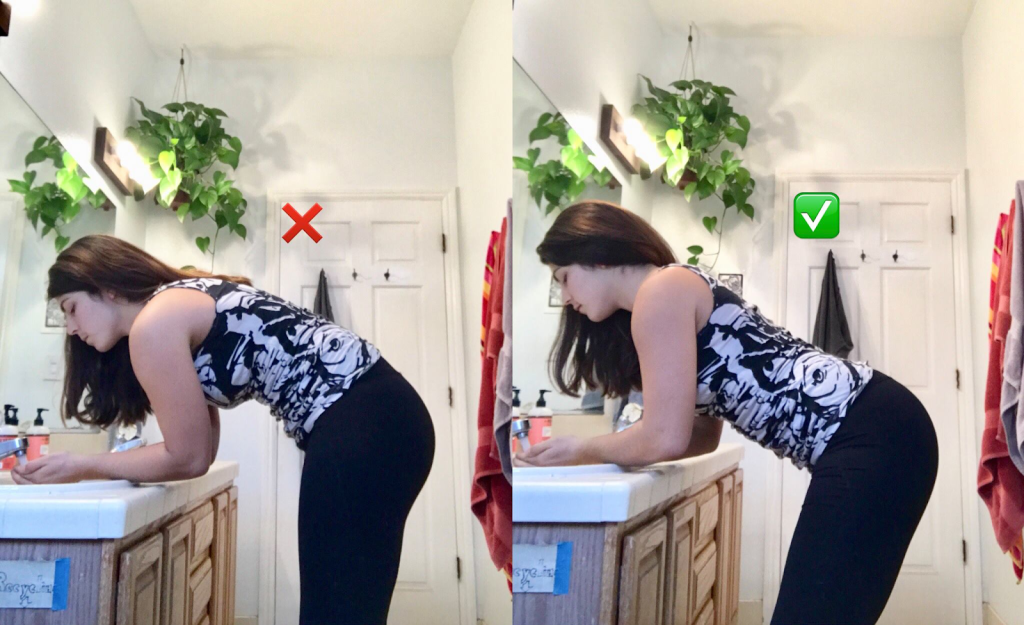Hip-hinges: 4 exercises in 1. Time spent: 0 seconds

I sometimes tell my students that if you bend well you are unlikely to have a back problem, and if you bend poorly you are almost certainly going to have a back problem. It’s almost that simple. Of course there are other important techniques to learn, like how to sit, stand, sleep, and walk, but bending is a particularly important technique, and learning to bend well constitutes a major milestone in our Gokhale Method Foundations course.
Most of us do many bends a day — each bend is an opportunity to benefit your structure, or destroy it. Turn each bend into a hip-hinge! You will preserve your discs, spinal ligaments, and knees instead of wearing and tearing them. You also get the following exercises taken care of:
Stretch your hamstrings
Stretch your external hip rotators
Strengthen your rhomboids
Strengthen your erector spinae muscles.
Time spent: 0! It doesn’t take a second longer to bend well than it does to bend poorly!

Comments
I've been in physical therapy
I've been in physical therapy for a couple of months to treat my lower-back pain, which was most intense when bending forward. Early on, my therapist said one goal of the therapy was to develop the strength and stability to bend over, with a round back, without pain; but he acknowledged that the goal is about range of motion and not for heavy lifting, etc. In light of your teachings, I've been wondering what you think of forward bending with a round back as a means to evaluate range of motion, strength, and stability. (For what it's worth, I now can bend forward with minimal pain—no pain if I do my PT exercises daily.)
I'm wondering what you think about this. And do you advise hip-hinging because rounding forward is a bad thing to do? Or do you advise hip-hinging because of its positive benefits (e.g., those listed in the post above)?
Both. Round-back bending
Both. Round-back bending loads the discs (edited) anteriorly, pushing the nucleosus pulposum (or filling) posteriorly - a particularly risky direction since the nerve roots lie just behind the discs.
Range of motion can be maintained better ways than habitual round-back bending.
I took the Foundations course
I took the Foundations course and the teacher said I did the hip hinging really well. However, I find that when I do it, I experience a tugging/ uncomfortable sensation in my lumbo/sacral region. It seems as though that region is taking the weight of my whole torso. What is causing this and how do I remedy it?
If there is inflammation
If there is inflammation where your erector spinae muscles attach to the sacrum, then hip-hinging should be postponed until the attachments heal. Hip-hinging does challenge the erector spinae muscles, which is usually a good way to strengthen them, but in the face of injury / inflammation give hip-hinging a break and use your knees to bend.
Hi Jesse,Yes, great question!
Hi Jesse,
Yes, great question! Both!
We tend to view the spinal shape slightly differently than some health professionals: we believe that the natural spine has a J-shape (as you will find in older medical literature), versus the commonly taught S-shaped spine (that you will find in modern medical literature). (See side by side images on page 12 in Esther Gokhale's book 8-Steps to a Pain-Free Back.) Using this perspective, we believe that rounding the back puts undue strain on the discs, ligaments and bones in the spinal column, which causes many types of problems over time. Of course, with good length in your back, it's possible to do this without immediate pain and could absolutely be used as one measure of motion strength and stability. But in our experience, rounding repeatedly over time will likely cause problems.
Meanwhile, people that spend many hours a day bending without any pain do this by hip-hinging, as demonstrated in the photo above. Not only does this type of bending prevent pain, but it allows for the beneficial stretches and improved strength we mention above. Another set of measures for range of motion, strength and stability could be appropriately applied to the hamstrings, external hip rotators, erector spinae and rhomboids - as improving length and strength in these muscles may well have better outcomes in allowing you to bend pain-free for the long-haul.
If your PT exercises are working for you, definitely stick with them! In the meantime, if you have a teacher nearby, consider taking a Gokhale Method Foundations course to get both a good understanding of how all of these disparate body parts are all connected and support each other and also how to create and support length and strength just doing your every day activities (like sleeping, sitting, bending and walking). Most of all though, tune in to your body and let that be your guide as you go about your day. It is so much more wise than we give tend to give credit in our intellectual culture!
Add New Comment
Login to add commment
Login